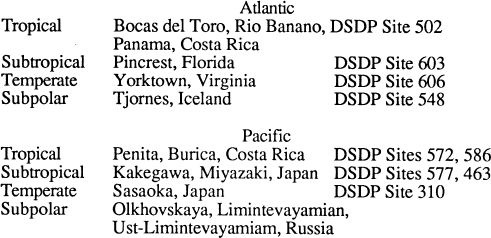No CrossRef data available.
Published online by Cambridge University Press: 26 July 2017
Pliocene faunal events in tropical and subtropical regions of the Americas and the Caribbean have been causally linked to global climatic events, particularly, progressive cooling and increased amplitude of climatic cycles between 3.5 and 2.0 Ma. However, the rate and magnitude of Pliocene temperature changes has been determined in only a few climate proxy records. Our study contrasts paleoceanographic conditions at 3 Ma, an extremely warm period in many areas, with conditions 2.4 Ma, a much cooler interval, in equator-to-pole transects for the North Atlantic and the North Pacific Oceans. By using microfaunal data (ostracodes from ocean margin environments and planktic foraminifers from deep sea cores), quantitative factor analytic and modern analog dissimilarity coefficient analyses were carried out on faunas from the following sections.

Our studies lead to the following conclusions: (1) Equator-to-pole thermal gradients in the oceans at 3.0 Ma were not as steep as they are today, but thermal gradients at 2.4 Ma were steeper than those today; (2)At 3 Ma middle to high latitudes were substantially warmer than today, but tropical regions were about the same; (3)Substantial cooling occurred in middle and high latitudes in the western North Pacific Ocean and the western North Atlantic between 3 Ma and 2.4 Ma; (4)Ocean water temperatures off the southeastern U.S. remained the same or cooled only slightly between 3 Ma and 2.4 Ma. Our results support the hypothesis that ocean circulation changes, probably resulting from the closure of near surface water by the Isthmus of Panama, had significant impact on equator-to-pole heat transport and global climate between about 3 and 2.4 Ma. They also argue against the hypothesis that climatically induced ocean temperature changes were directly linked to a major marine extinction in the southwestern North Atlantic and Caribbean.